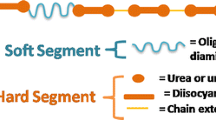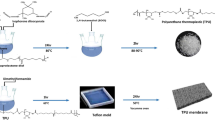Abstract
Two different diene monomers [dicyclopentadiene (DCPD) and 5-ethylidene-2-norbornene (ENB)] as self-healing agents for polymeric composites were microencapsuled byin situ polymerization of urea and formaldehyde. We obtained plots of the storage modulus (G′) and tan δ as a function of cure time by using dynamic mechanical analysis to investigate the cure behavior of the unreacted self-healing agent mixture in the presence of a catalyst. Glass transition temperatures (T g ) and exothermic reactions of samples cured for 5 and 120 min in the presence of different amounts of the catalyst were analyzed by differential scanning calorimetry. Of the two dienes, ENB may have advantages as a self-healing agent because, when cured under same conditions as DCPD, it reacts much faster in the presence of a much lower amount of catalyst, has no melting point, and produces a resin that has a higher value ofT g . Microcapsules containing the healing agent were successfully formed from both of the diene monomers and were characterized by thermogravimetric analysis. Optical microscopy and a particle size analyzer were employed to observe the morphology and size distribution, respectively, of the microcapsules. The microcapsules exhibited similar thermal properties as well as particle shapes and sizes.
Similar content being viewed by others
References
S. R. White, N. R. Sottos, P. H. Geubelle, J. S. Moore, M. R. Kessler, S. R. Sriram, E. N. Brown, and S. Viswanathan,Nature,409, 794 (2001).
M. R. Kessler and S. R. White,Composites, Part A,32, 683 (2001).
M. R. Kesseler,Characterization and Performance of a Self-Healing Composite Material, PhD Dissertation, University of Illinois at Urbana-Champaign, 2002.
M. R. Kessler, N. R. Sottos, and S. R. White,Composites, Part A,34, 743 (2003).
M. Feve,Makromol. Chem., Macromol. Symp.,30, 95 (1989).
R. B. Prime, J. M. Burns, M. L. Karmin, C. H. Moy, and H.-B. Tu,J. Coat. Tech.,60, 55 (1988).
R. H. Grubbs and M. Sanford, inRing Opening Metathesis Polymerization and Related Chemistry, E. Khosravi and T. Szymanska-Buzar, Eds., Kluwer Academic Publishers, Dordrecht, 2002, Part I.
Y. S. Yang, E. Lafontaine, and B. Mortaigne,Polymer,38, 1121 (1997).
J. C. Mol,J. Mol. Cat.,213, 39 (2004).
Author information
Authors and Affiliations
Rights and permissions
About this article
Cite this article
Lee, J.K., Hong, S.J., Liu, X. et al. Characterization of dicyclopentadiene and 5-ethylidene-2-norbornene as self-healing agents for polymer composite and its microcapsules. Macromol. Res. 12, 478–483 (2004). https://doi.org/10.1007/BF03218430
Received:
Revised:
Issue Date:
DOI: https://doi.org/10.1007/BF03218430




